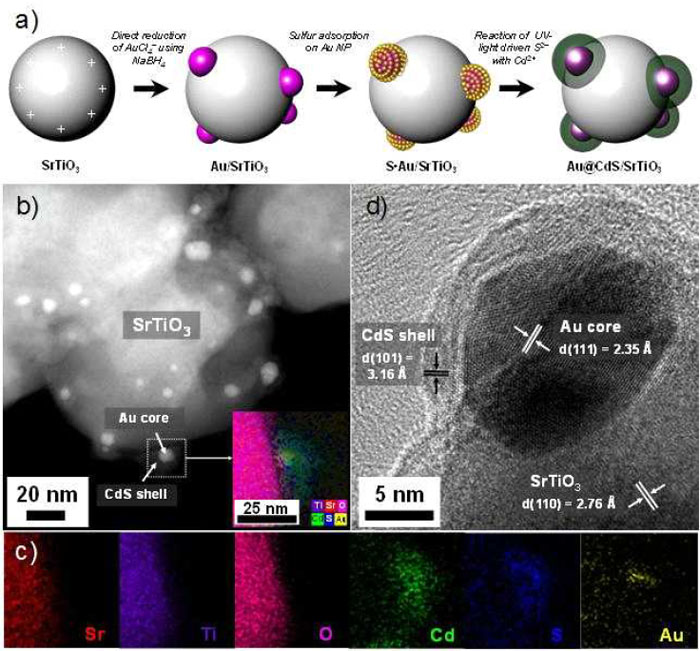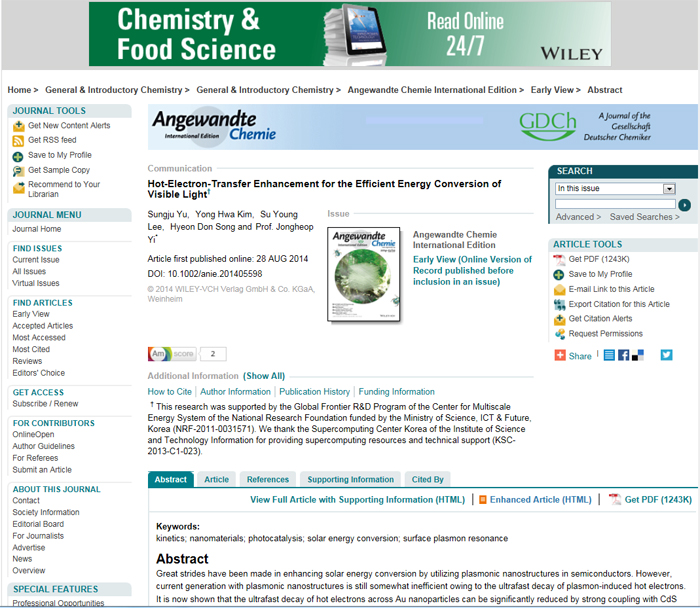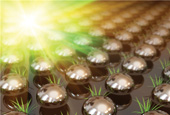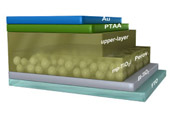Scientists at Seoul National University (SNU) have developed a new technology to mass produce hydrogen (H2), a next-generation energy source, simply by casting sunlight onto water.
The researchers succeeded in generating from water 74 times more hydrogen using the visible rays that make up over 40 percent of sunlight, rather than using existing technologies, announced the Ministry of Science, ICT and Future Planning on September 15. The scientists used gold plasmonic nanostructures in semiconductors that can separate hydrogen from water by applying visible light.
Gold plasmonic nanostructures can generate hot electrons and separate hydrogen from water. In the past, researchers had to use ultraviolet rays, which are much stronger than visible light. Ultraviolet rays, however, account for only a small portion of sunlight and there is a fundamental limit to the technology's commercialization.

The problem is the ultra-fast decay of plasmon-induced hot electronics, which makes it very inefficient. So the scientists developed new nanostructures by adding two nano particles to the existing gold plasmonic nanostructures and significantly lengthened the life of the hot electrons.
As a result, the researchers were able to produce 74 times more hydrogen than using just normal gold plasmonic nanostructures.
The newly developed nanostructures not only produce hydrogen, but can also harvest electrons under irradiation with visible light. The technology is expected to be highly applicable in the use of solar energy.
"The new technology can provide electricity to electronics and automobiles and does away with the need for gasoline or electricity from an outside source," said a researcher. "With further research, the technology will be commercialized in one or two years."

The research was supported by the science ministry and the research findings were published in Angewandte Chemie, a chemistry journal, on August 28.
By Limb Jae-un
Korea.net Staff Writer
jun2@korea.kr

The researchers succeeded in generating from water 74 times more hydrogen using the visible rays that make up over 40 percent of sunlight, rather than using existing technologies, announced the Ministry of Science, ICT and Future Planning on September 15. The scientists used gold plasmonic nanostructures in semiconductors that can separate hydrogen from water by applying visible light.
Gold plasmonic nanostructures can generate hot electrons and separate hydrogen from water. In the past, researchers had to use ultraviolet rays, which are much stronger than visible light. Ultraviolet rays, however, account for only a small portion of sunlight and there is a fundamental limit to the technology's commercialization.

The structure and formation of gold plasmonic nanostructures, as seen through an electron microscope: (a) the synthesizing of nanostructures; (b) the image of Au@CdS core-shell structures scattered on the nanostructures; and, (c) mapping the second nano particles.
The problem is the ultra-fast decay of plasmon-induced hot electronics, which makes it very inefficient. So the scientists developed new nanostructures by adding two nano particles to the existing gold plasmonic nanostructures and significantly lengthened the life of the hot electrons.
As a result, the researchers were able to produce 74 times more hydrogen than using just normal gold plasmonic nanostructures.
The newly developed nanostructures not only produce hydrogen, but can also harvest electrons under irradiation with visible light. The technology is expected to be highly applicable in the use of solar energy.
"The new technology can provide electricity to electronics and automobiles and does away with the need for gasoline or electricity from an outside source," said a researcher. "With further research, the technology will be commercialized in one or two years."

Research findings are published in Angewandte Chemie, a chemistry journal, on August 28.
The research was supported by the science ministry and the research findings were published in Angewandte Chemie, a chemistry journal, on August 28.
By Limb Jae-un
Korea.net Staff Writer
jun2@korea.kr
Related Contents
Most popular
- Korea.net welcomes 2025 K-influencers, Honorary Reporters
- 2025 Honorary Reporter class pledges to spread 'real Korea' worldwide
- Slew of festivals, events scheduled in downtown Seoul in May
- US urged to exempt tariffs on Korea in first '2+2' trade talks
- Korean culture festival in Cuba marks 1st year of bilateral ties



